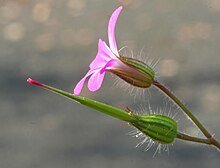Beak (botany)



In botany, the term beak or rostrum usually refers to a beak- like, rather straight, mostly rigid and seedless extension of the stylus section in fruits . Such formations occur mainly in some cruciferous (Brassicaceae) or umbelliferae (Apiaceae), but also in the genus cranesbill ( Geranium ) and in some achenes of the sunflower (Asteraceae). Even seeds of some species, such as strophanthus , can have a beak.
Other flower or plant parts such as the shuttle in butterfly flowers , anthers or stigmas can be beaked.
The term is also applied to the long, beak-shaped lid of the capsule ( kalyptra ) of some types of moss . Long-billed capsules, for example, have representatives of the genus Schönschnabelmoose ( Eurhynchium ).
If the beak is more bent, curved and horn-like, it is also called horn (cornu).
swell
- Frank Müller, Christiane Ritz, Erik Welk, Karsten Wesche: Rothmaler - excursion flora from Germany, vascular plants: Critical volume. 11th edition, Springer Verlag, Berlin / Heidelberg 2016, ISBN 978-3-8274-3132-5 , p. 198.
- Gottlieb Wilhelm Bischoff : Handbook of botanical terminology and systems science. First volume, Schrag, 1833, p. 579.